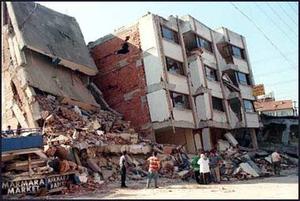DisastersCalifornia prepares for the Big One
The scientific community in California is growing more and more wary of the potential for a major seismic event since the last that occurred was in 1857; a recent study projected that there was a 99 percent chance that a 6.7 magnitude earthquake would strike somewhere in California during the next thirty years

Aftermath of a California earthquake // Source: stuckiniowa.com
According to the U.S. Geological Survey (USGS), more than three million earthquakes occur every year, which amounts to approximately 8,000 a day. It is not surprising, then, that the scientific community in California is growing more and more wary of the potential for a major seismic event since the last that occurred was in 1857. Earthquake trends show that intervals between quakes have been as short as 45 years or as long as 145 years. Considering that it has been nearly 154 years since the last major quake, the San Francisco Bay Area, Delta Region, and Central Valley prepares for the worst.
A study conducted in 2008 the USGS, the California Geological Survey, and the Southern California Earthquake Center — titled “Uniform California Earthquake Rupture Forecast” — examined the probabilities of future earthquakes. According to the study, it was projected that there was a 99 percent chance that a 6.7 magnitude earthquake would strike somewhere in California during the next thirty years.
There were lower probabilities that such a damaging earthquake would strike specific areas within the state. The two faults that are more likely to generate catastrophic earthquakes of magnitude 7 or greater are the Hayward Fault, which runs down the east side of San Francisco Bay and last ruptured in 1868 (with an average recurrence interval of 140 years), and the southern portion of the San Andreas Fault, which has not ruptured for over 300 years.
The Federal Emergency Management Agency (FEMA) maintains several grant programs that would provide funding to allay the effects of a major natural disaster. One of them, the $2.3 million Earthquake Hazards Reduction State Assistance Program, was established in 2009 to provide support in assessing the impact seismic hazards pose towards critical structures and lifelines.
The program has been divvied up among thirty-three states and territories, providing baseline assistance of $50,000 per state with remaining funds distributed based on risk. As it bears the largest risk, California receives more than any other state.
The assistance is distributed through cooperative agreements in which the receiving states and territories also bring something of value to the table, whether through other disaster mitigation programs or in-kind contributions such as staff time or low-cost aid from state universities. In an interview with Homeland Security NewsWire, Edward M. Laatsch, chief, building science section, risk reduction branch, mitigation division, commented on the benefits of such an interchange: “In the case of California, these funds
